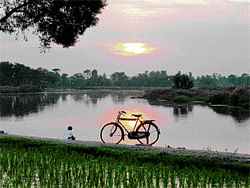Kannan Kasturi travels to the small town of Suttur near Mysore and is fascinated by the sights and sounds of the town by the Kapila, also known as the Kabini.

We walked down to the roundabout that marked the entrance to the town and then took the road heading out. A few paces on, we came to a bridge across a river.
A picture-postcard-perfect moment. We had not seen anyone else on the road, but there were the proverbial early birds for company, and literally so.
A black and white wagtail perched on the railing of the bridge, a snow-white egret waded close to the weeds on the riverbank. Crossing the river, the road cut a straight path through the fields.
Day was yet to break and land, river, and sky appeared in muted colours. We walked through a vast flat expanse of green marked by strips of brown. Occasionally, we passed a field that was flooded, reflecting mirror-like, the trees standing beyond, in the dim and diffuse light.
We were in rural Karnataka, in the small town of Suttur, about 30 km south east of Mysore. The river flowing by the town is the Kabini, more commonly called by the beautiful name Kapila in these parts. Suttur is chiefly known for the Mutt of Veerashaiva saint Jagadguru Shivarathreeshwara and the annual jathre (fair) organised by the Mutt, and visited by lakhs of farmers.
Our first foray outside was to the ghat on the Kapila, just five minutes away. The walk took us through paddy fields with standing water stretching all the way close to the river. Stone steps then led down to the river and we sat down to enjoy the view. Swallows perched in a row on an overhead electricity line, biding their time to swoop down and catch flying insects.
A flock of cormorants, looking out into the flowing water, occupied a large boulder jutting out from the river. The Kapila had a gentle flow and looked ever so peaceful, reflecting the setting sun that was forcing itself, though weakly, through the clouds. In the evening, we took a walk on the road through the fields. The sun had disappeared and had lit up the western sky in magnificent colours. Evenings and mornings are truly to be savoured here.
Our stay in Suttur extended over several days and we visited the shrine of Shivarathreshwara and enjoyed a free lunch along with scores of others at the Dasoha Bhavana run by the Mutt.
Hadinaru kere
The lake is next to Hadinaru village, about 10 km from Suttur on the Nanjangud road. Making our way through the vegetation to get near the lake, we noticed a large flock of what seemed to be mainly Glossy Ibis – glistening black birds with slender curved bills - standing in the shallow waters.
As we got closer, an awkward looking Grey Pelican sensed our presence and started to move away. Another few steps and the Ibis took flight, filling the sky with wings. Little reedy islands stuck out of the lake. On one, there was a clutch of cormorants looking inward, seemingly engaged in their own Panchayat. We could see large flocks gathered in the further reaches of the lake, but it was too late to walk any further. The sun was going down and we started making our way back.
Across the metal road from the bund of the lake was a canal, and beyond that, fields in different shades of green, extending as far as the eye could see – a restful sight for tired eyes. Meanwhile, I turned towards the lake and spotted a cluster of colourful birds resembling ducks - with a broad white stripe above the eye and blue in their wings.
I later identified these as Garganey, winter visitors, which Salim Ali informs, fly all the way from Northern Europe, and other similar latitudes to escape the harsh winters. The sun had now become a disc of fire behind a tree. We had barely sampled the rich variety of birds that the lake hosted and it was time to leave. In Hadinaru kere, we chanced upon a quiet haven for the serious bird watcher, free of the noise and bustle of tourists who throng its illustrious neighbour, Ranganathittu.
On another day, we made a stop on the roadside near the town of Chikkahalli on our way to Mysore on the T Narsipura road. Crossing a living fence, we entered a large plain field, in the middle of which stood this gigantic banyan tree, which the local residents refer to as the ‘Dewara Mara’ (tree of the gods).
The tree is believed to be over 200 years old and covers an area more than an acre. ‘Dewara Mara’ had a pleasant symmetry about it, its trunks looked stolid and its leaves glowed with health, though old it maybe.
Looking back on our trip to Suttur, I think of the many places that we could not visit – the ancient Shiva temple at Nanjangud, the confluence of the Kapila and the Cauvery at Narasipura, the sands of Talakad with their buried treasures.
And the many questions that we did not ask - like who decided to shorten the beautiful name Tirumakudalu to T in T Narasipura. All this of course means that we will come to see the Kapila again.